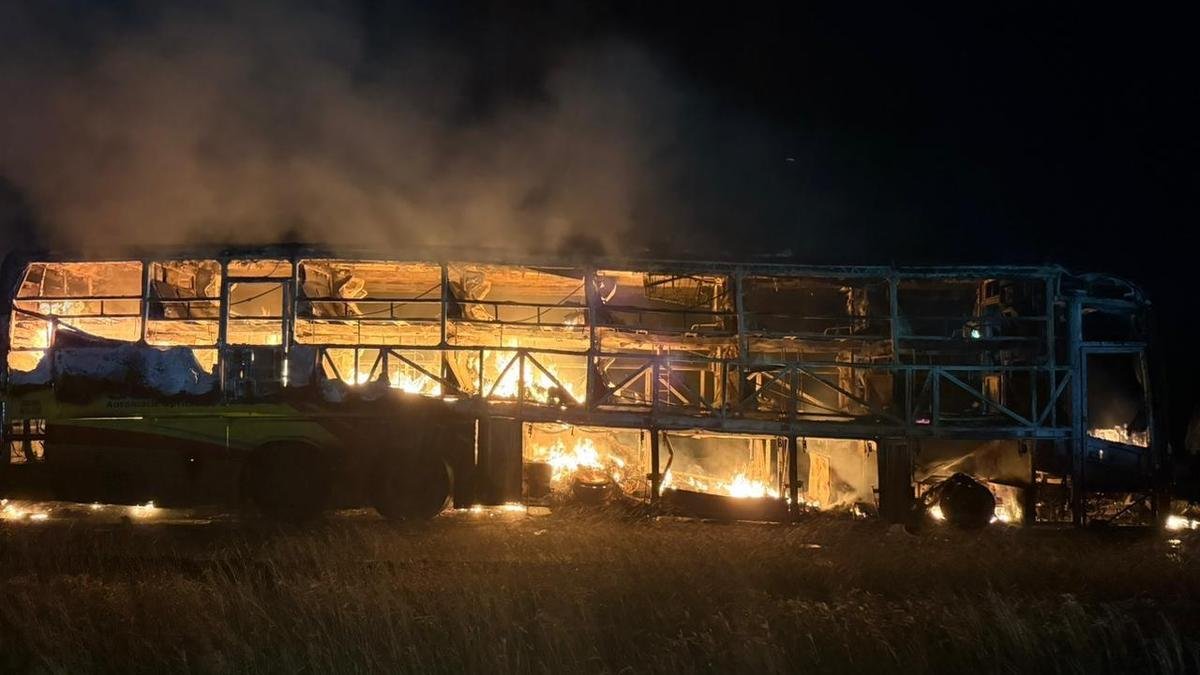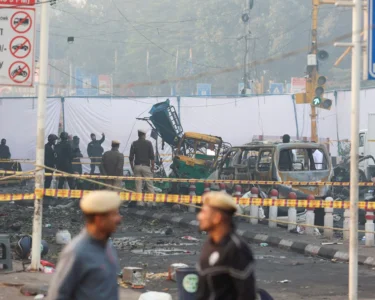At approximately 3:30 a.m. on Friday, a private sleeper coach operated by Kaveri Travels en route from Hyderabad to Bengaluru was involved in a catastrophic accident near Chinna Tekuru village in the Kurnool District of Andhra Pradesh. The bus reportedly collided with a two-wheeler, which got lodged beneath it and appears to have triggered an intense fire that spread rapidly and consumed much of the vehicle. The News Minute+2mint+2
Initial reports indicate that around 40 passengers—including children—were on board. At least 20 passengers were killed and 12 or more suffered burn-injuries; the final toll may rise as investigations continue. The News Minute+1
Eyewitnesses described harrowing scenes: as the blaze erupted, many passengers were asleep, doors jammed or blocked by flames, and thick smoke filled the vehicle. Some survivors managed to break windows or escape via emergency exits; others tragically could not. The News Minute+1
Response by State Leaders
Andhra Pradesh
N. Chandrababu Naidu, Chief Minister of Andhra Pradesh (who is currently abroad), expressed profound shock upon learning of the incident. He posted on social media that the accident was “devastating”, offered his condolences to victims’ families, and assured that all possible support would be extended to the injured and the bereaved. He also directed senior officials to visit the site and oversee relief measures. mint+1
Telangana
A. Revanth Reddy, Chief Minister of neighbouring Telangana, likewise conveyed his heartfelt condolences and directed state officials to coordinate immediately with Andhra Pradesh authorities. He ordered the setup of a helpline, instructed district officials to reach the site at once, and emphasised that medical assistance and relief programmes must be put into action on a “war footing”. The Statesman+1
Relief Measures & Investigation
Authorities in both states have swung into action. In Andhra Pradesh, forensic teams and the transport department are investigating the exact cause of the fire, including how the collision may have triggered it, and whether safety protocols in the bus were adequate. The News Minute+1
In Telangana, the Chief Minister’s directive includes monitoring the medical care of injured persons, coordinating with hospitals, and ensuring that families of deceased receive prompt assistance. The Economic Times
At the national level, it has been reported that an ex-gratia payment will be provided to the next of kin of the deceased, and compensation to the injured, though the precise figures are still being confirmed. www.ndtv.com
Underlying Issues & Safety Concerns
This incident has once again highlighted serious concerns regarding road transport safety on major highways in India:
- The bus collided with a two-wheeler that became lodged beneath it; preliminary reports suggest the fuel tank or other combustible material may have ignited the blaze. The News Minute+1
- Many passengers reportedly could not escape in time — doors may have been blocked, passengers were asleep, and the fire spread quickly through the coach. The News Minute
- Questions arise about emergency-exit protocols, fire suppression systems in long-haul sleeper coaches, driver training and supervision, adherence to regulatory safety norms, and oversight of transport companies.
- Prior similar tragedies (such as the 2013 bus fire in the then-Andhra region) point to recurring systemic failures when it comes to fire-safety standards in passenger road transport. Wikipedia
What the Tragedy Means for Passengers, Families and the Sector
For the families of those who perished or were injured, this is a moment of profound grief and trauma. The rapid nature of the fire and the fact that many were asleep heighten the anguish. The state governments’ assurances of help are a vital immediate step—but long-term support will be needed for rehabilitation, compensation, counselling and possibly legal recourse.
For the transport sector, this tragedy is a warning. Operators of long-distance buses must ensure:
- Proper maintenance of vehicles, including functioning emergency exits, fire extinguishers, smoke alarms.
- Driver and crew training in emergency procedures, evacuation drills and rapid response to fire/smoke.
- Monitoring of routes with high risk (e.g., early-morning travel when many passengers may be asleep) and ensuring rest breaks.
- Coordination with state transport authorities and road safety organisations to enforce stricter compliance.
For the public and passengers: vigilance when choosing transport operators, observing travel-safety protocols, checking for emergency-exits and available safety equipment, and avoiding travelling in vehicles which appear poorly maintained or overloaded.
A Call to Remember — and to Act
As the investigation continues and relief efforts proceed, this incident must serve both as a moment of remembrance for lives lost and as a catalyst for change. The immediacy of the leaders’ responses reflects the gravity of the event, but lasting improvement will depend on robust regulation, enforcement and culture change in road transport safety.
The sorrow of this event is compounded by the sense of preventability: a collision followed by a fire, passengers trapped, insufficient escape time. If such incidents are to become rarer, vigilance and action by all stakeholders — government, transport operators, frontline staff and passengers alike — are indispensable.
In Condolence
We extend our deepest sympathies to the families and friends of those who lost their lives in this tragedy, and our wishes for a full recovery to those who were injured. May this event galvanise all concerned to ensure that no other passenger faces such horror on our roads.







